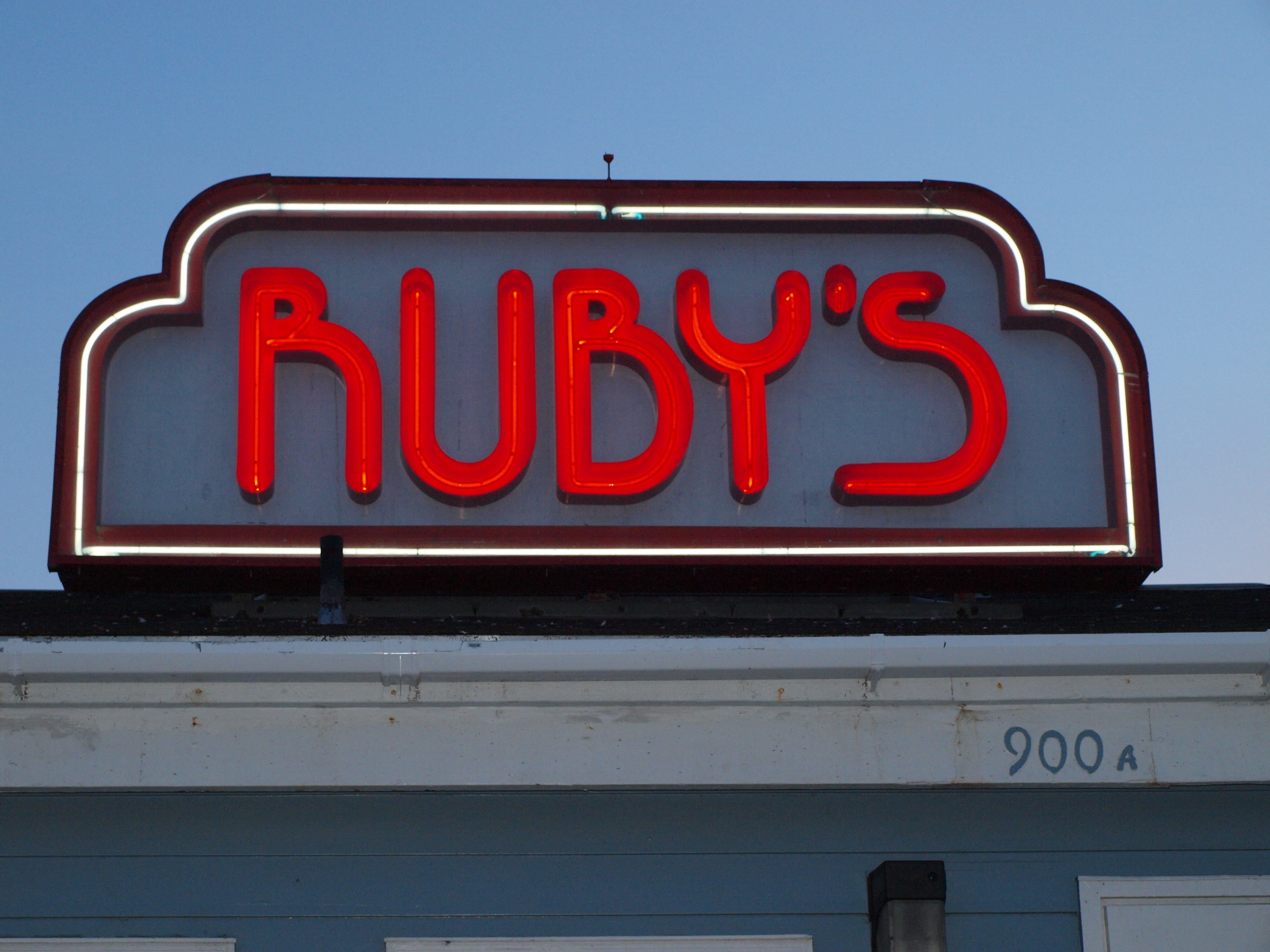
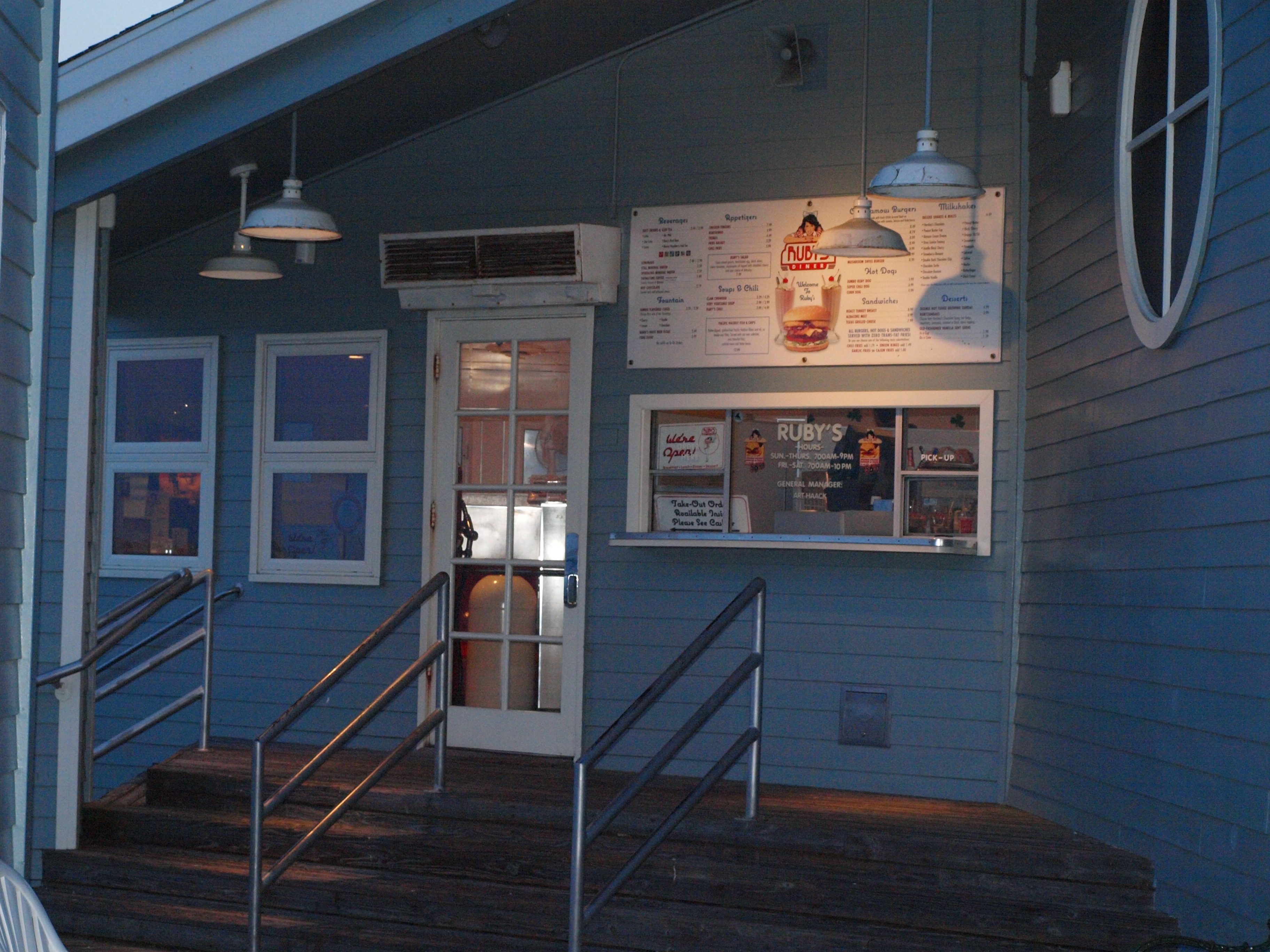
Ruby’s — 2011
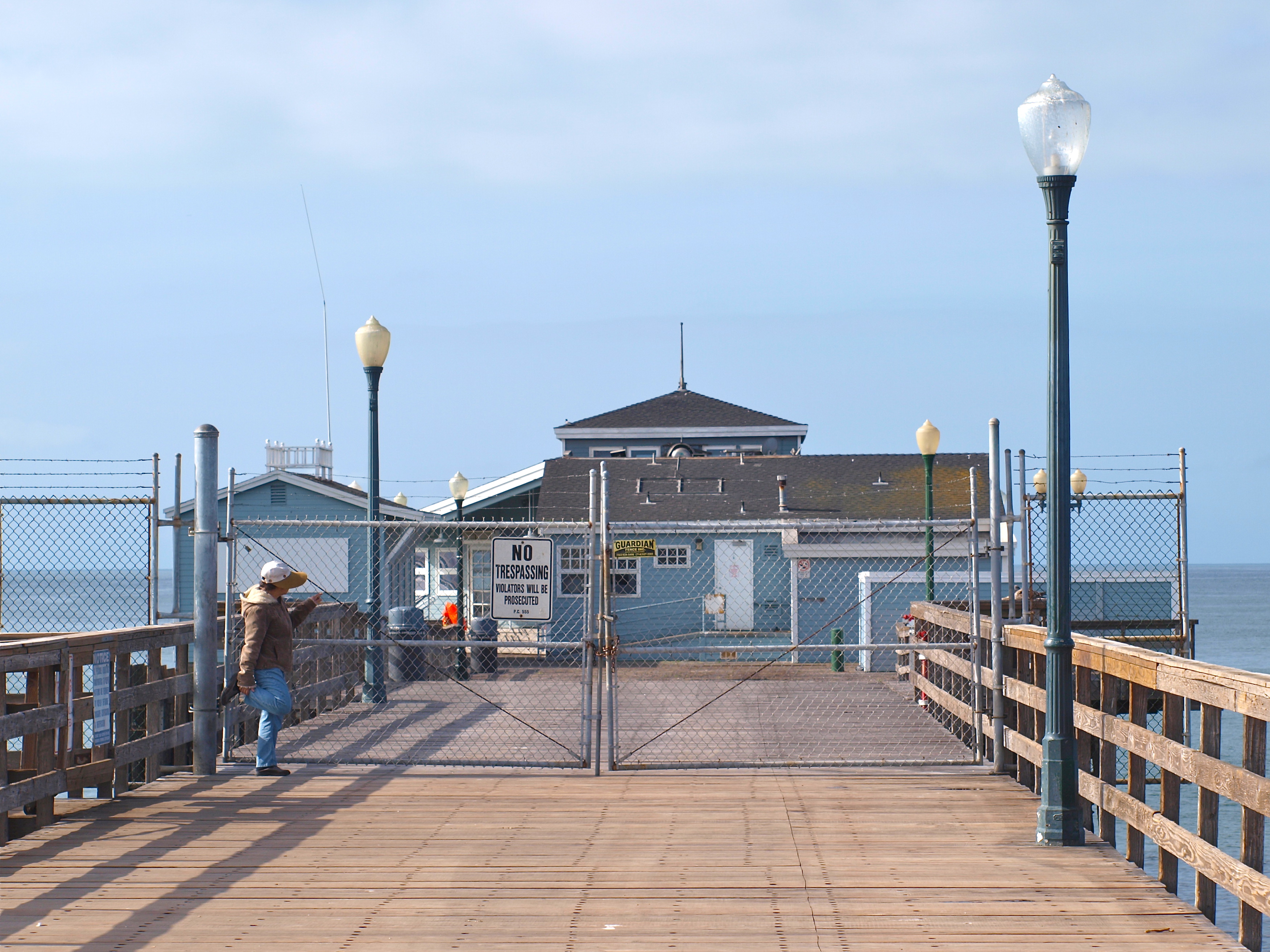
Seal Beach Pier — End Section — 2014
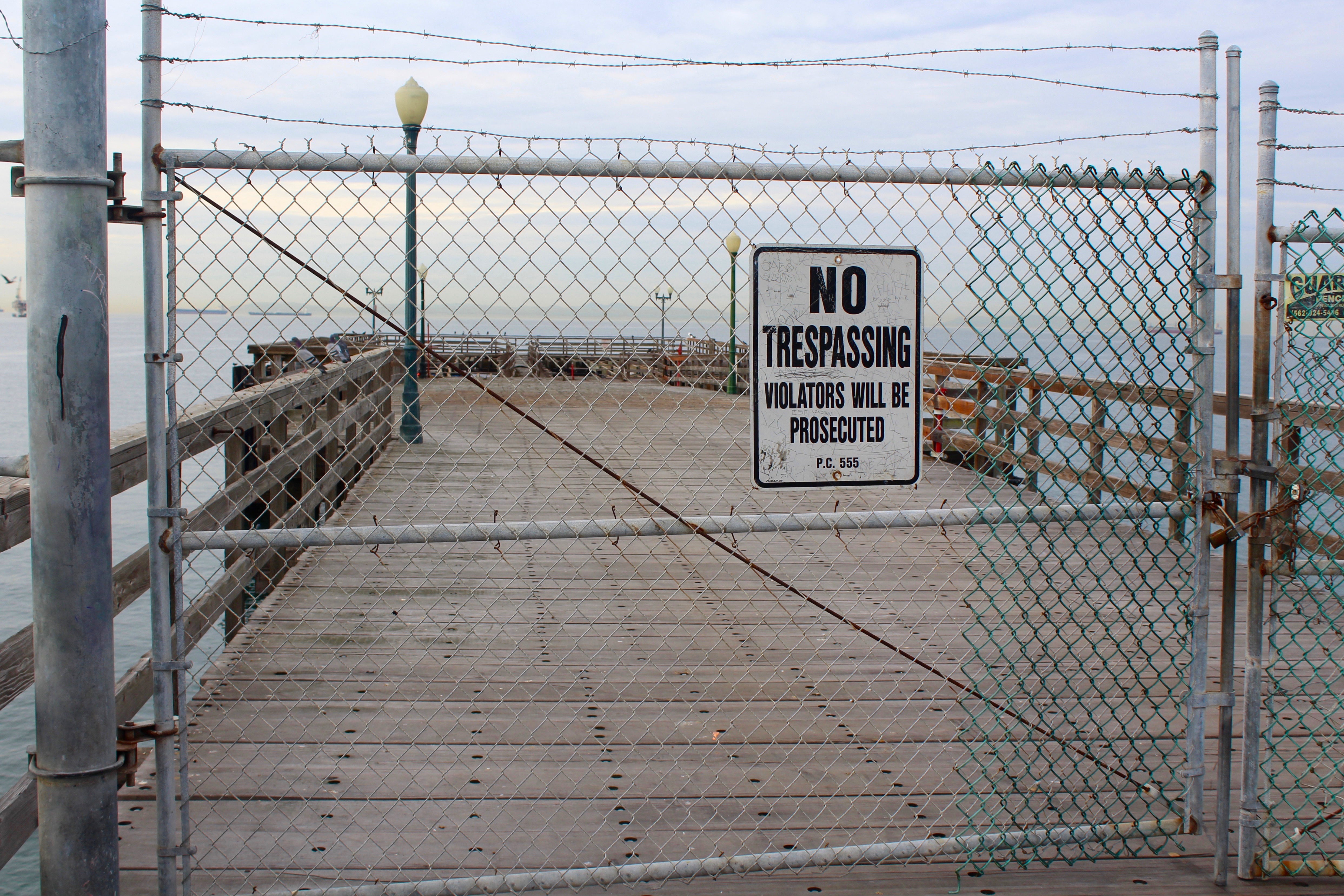
Seal Beach Pier — End Section — 2018
History Note. Like many, if not most, of the coastal cities in Orange County and Los Angeles County, Seal Beach experienced much of its growth as a result of the efforts of local real estate developers, in this case Philip A. Stanton and his Bayside Land Company. Stanton, who had been an early promoter of the nearby Huntington Beach area before selling his share of that land, took a sleepy little burg called Bay City and developed it into one of the leading resort centers in the area. Prior to Stanton’s entrance into the scene the immediate area had little population even though it had long been a favorite spot for summertime vacations.
German Burghers who had settled Anaheim (“Ana” for the Santa Ana River and the German “heim” meaning home) had developed Anaheim Landing in the nearby bay in the 1860s as a port from which to ship out their produce. They also discovered that the local beaches made a great spot to escape the hotter climate of their inland city—even though only a dozen or so miles away. However, year-round settlement was limited. In fact, J.C. Ord, considered one of the fathers of Seal Beach, was the lone resident in 1901.
Bay City grew at a slow rate in the early 1900s but began to grow more rapidly after the Pacific Electric Railway entered the town in 1904. Easier access in and out of the area provided impetus for the development of hotels, bathhouses and dance halls. It also gave purpose for the development of a pier (since every beachside resort needed a pier). In 1906 the original Seal Beach Pier (Bay City Pier?) was built; at 1,865 feet it was (at the time) the longest pier south of San Francisco.
Pleasure Pier At Bay City — Contract Let for Extensive Improvement at Attractive Coast Resort
Another new pleasure pier is about to be added to those providing enjoyment for Southern California and coast resort visitors. Contracts have already been let to Mr. Mercerenu for building a 1500-foot pier at Bay City. This will be the longest pleasure pier in Southern California, the one at Long Beach alone excepted, and Mr. P. A. Stanton, the agent for Bay City, says it will be completed by June 1. Grading and side-walking of all streets in Bay City not so improved is now in progress. The proposed new hotel of sixteen rooms, and a large dining room together with several storerooms on the ground floor, will be constructed at the corner of Main and Central avenue. —Los Angeles Herald, March 4, 1906
Bay City — The Safe Beach
Bath House and Restaurant at Anaheim Landing — Two Fine Still Water Bays
A Mile of Magnificent Ocean Frontage — The Best Street Work to Be Found at Any Beach Town in Southern California
Longest Pleasure Pier in Southern California With One Exception to Be Built at Once
Lots from $500 to $1000. Easy Terms
P.A. Stanton, 316 West Third Street, Office at Bay City Open
Every Day Including Sunday
—Los Angeles Herald, April 29, 1906
Although Stanton had hoped his town would become the “The Coney Island of the Pacific,” and the “playground of Southern California,” (sentiments echoed by many developers of the day, i.e., those in Long Beach and the Redondo Beach-Santa Monica corridor) it would take nearly a decade for his dream to reach fruition. Real growth and true development as a resort center would not take place until 1915-16 after the city incorporated (as Seal Beach).
A new figure now entered the mix. Frank Burt, manager of the concessions at the 1915 Panama Pacific Exposition in San Francisco, moved south following the closing of the Exposition and helped found the Jewel City Amusement Company. With Stanton’s cooperation, a new pier was built to replace the original pier.
The new pier became the center of the “Jewel City” amusement area. The Jewel Cafe to the north, and a Bathhouse and Dance Pavilion to the south, flanked the pier at its shore side end. According to reports the cafe’s opening night saw a “banquet from the sea” for 500 people. Dishes included albacore, barracuda, clam chowder and oyster cocktails. The huge Bathhouse contained 1,000 dressing rooms that opened directly onto the beach; their motto was “A beach without an undertow.” To the south of the pier set the Derby, the racer roller coaster brought down from San Francisco. A final touch was added by the addition of the “Scintillator” lights, also brought down from San Francisco, fifty-two huge lamps which projected changing rainbows of light onto the water for nighttime bathing.
At its height during the 1920s, as many as 20,000 visitors came to Seal Beach and its “Joy Zone” each week, many if not most arriving on the Pacific Electric’s big Red Cars.
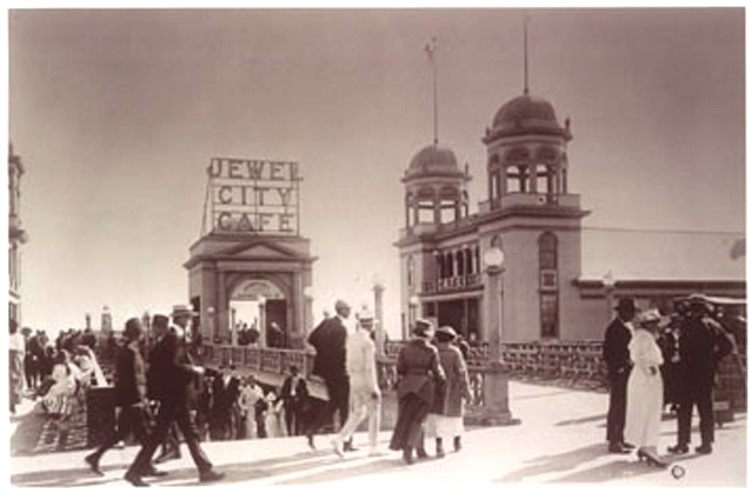
Jewell City Cafe
Pier fishing and barge fishing were, of course, two of the main attractions of the pier itself. Fishing was considered good at the pier but when it slowed down anglers would simply switch to the angling found in the deeper waters by the barge. The first barge at Seal Beach, the James McKenna, began operating in 1925. Additional barges would begin operation in 1939, the F.S. Loop and the Homer.
By the ’30s the city itself was well established but the affects and challenges of the Great Depression, including less discretionary money for amusement, would lead to the decline of the amusement area and its eventual closure in 1937. Although the joy in the “Joy Zone” would seem to have been at an end, the city itself seems to have developed quite a reputation for “sin”—including illegal “speakeasies,” gambling and prostitution. Apparently the area was still joyful for some.
Meanwhile “Mother Nature” and simple old age would affect the pier. Although the pier survived the 1933 earthquake intact, two hurricanes had tremendous impact on the pier. In 1935 huge waves, caused in part by a hurricane in the Philippines, ripped into and partially destroyed the pier. The center portion was lost which left the outer end isolated. Although there would be a four-year closure, a new pier would emerge from the splintered remains.
Seal Beach Pier Rescue May Speed Replacement
Collapse of a section of the privately owned Seal Beach pier Tuesday night, which marooned sixteen persons on the structure until Coast Guardsmen ferried them to a cutter, will result in hastening the construction of a municipal pier and breakwater closer to the entrance to Alamitos Bay, officials declared last night. The project, calling for an expenditure of $82,000, has been approved by Federal Public Works officials and plans have been completed.
Stub pilings near the outer end of the pier prevented Cutter 254 from getting alongside the pier end in the rescue. The cutter anchored 230 feet off the pier and played its searchlight in the rescue operation. In a bos’n’s chair, the marooned women were lowered to the dory, which made eight trips between the pier and the cutter. The damaged pier is the property of the Bayside Land Company, which developed Seal Beach. Company officials have not determined the future policy of the concern as to repair or improvement to the structure. —Los Angeles Times, July 4, 1935
Pier Dispute Pact Sought
SEAL BEACH, Feb. 6 — An effort to reach a friendly settlement in litigation pending between the city of Seal Beach and the Bayside Land Company over the old wharf will be sought Tuesday. The council has sent an invitation to P.A. Stanton, president of the land company, asking him to attend a special meeting of the council at 10 a.m. Condemnation proceedings against the pier are now in the courts and will be heard February 11. Councilmen are seeking to make a settlement prior to that hearing. The tottering old pier is declared hazardous to navigation and unsafe for the use of fishermen. The council has had plans and specifications drawn up for the construction of a new pier. —Los Angeles Times, February 7, 1938
Seal Beach to Vote on Pier Bond Issue
SEAL BEACH (March 7) —Voters will pass on a $101,500 bond issue for construction of a new pier at the city election, April 12, The City Council will meet Thursday to complete plans for the election. The city has made application to the State Division of Lands for permit to construct the pier. It is expected that the grant will be made as soon as the case against the Bayside Land Company is settled in Superior Court in Santa Ana. It also is expected that the case will be settled satisfactorily for the city, officials believe. The issue will be placed on the spring ballot to save the expense of a special election. The old wooden pier was built in 1916 and has been declared unsafe for years. —Los Angeles Times, March 8, 1938
Plaques that sit near the front of the pier give evidence of the pier’s history and resiliency. One says, “Federal Emergency Administration of Public Works, 1938, Project No. Calif. 1723-F.” It represents the rebuilding necessitated by the storms and hurricane-related wave damage of 1935.
Unfortunately, one year later would see California’s only recorded hurricane, the 1939 chubasco (sometimes called the Long Beach Tropical Storm “El Condonazo” or “The Lash of St. Francis”) moved up from Central America to Baja before hitting Southern California. The hurricane ripped the recently finished new pier in half but luckily this time the pier was quickly repaired, at a cost of $110,000. It was just a year later that the pier was reopened. These two repair projects, in 1935-38 and 1939, were just two of many to be seen at the pier—although more than 40 years would see relative peace.
When open, the pier remained a well-used resource by many, especially fishermen. By the 1940s, and continuing for many years, anglers at the pier were offered the choice of pier fishing, fishing from barges, or fishing from live bait boats.
Barracuda Plentiful but Fast and Fighty in Offshore Waters
Piers were crowded with surf anglers yesterday and boats going out from Long Beach and Seal Beach were well loaded. Captain Jack E. Tubbs, Seal Beach pier manager, is putting his live bait barge in service several days earlier than he had planned. The vessel, called the “Homer,” a low built schooner, will have its inaugural Saturday. It will be anchored on Seal Beach reef, about a mile and a quarter from Seal Beach pier, docking place for the water taxis which give shuttle service hourly. In addition Captain Tubbs has six live bait boats in operation. —Long Beach Independent, April 9, 1940
New Seal Beach Pier
Three Live Bait Boats And Barge
Boat “Bearcat” Daily 3 A.M. — Boat “Lets Go” Daily 5 A.M.
Boat “Moose II” Daily 7 A.M. — Barge “Homer”
Boats Hourly 9 A.M. to 4 P.M. — Live Bait for Pier Fishing
Café, Fish Market and Tackle Store — Outer End of Pier
For Further Information Call Long Beach 339-76
—Long Beach Independent, April 28, 1940
Halibut on Piers — If you can’t find the barracuda, stay on the pier and let ‘em come to you. It was that sort of a day Wednesday, when many boaters came home empty handed. Pier fisherman posted some fine scores. On Seal Beach pier, John Kurt of Leisure World checked in a 7-½ pound halibut, Steve Praee one at 6-1/2 pounds, and Reuben Flores, Pico Rivera, a 5 ¼-pound flounder. There were about three dozen flatties spotted on the pier and many barracuda than rab about 2 ½-pounds. —Lew Allison, Ocean Roundup, Long Beach Press Telegram, May 16, 1963
Just Fishin’ — Captain Jack Tubbs’ island boat from Seal Beach Pier took out a party of Los Angeles newspaper people Wednesday and brought them back happy with good catches of barracuda, yellowtail and sea bass. Continued good halibut fishing was reported from the barge Homer, off Seal Beach… Surf fishing was a trifle slow, corbina and spotfin being the chief catches, and halibut and herring off the piers. —Long Beach Independent, June 28, 1940
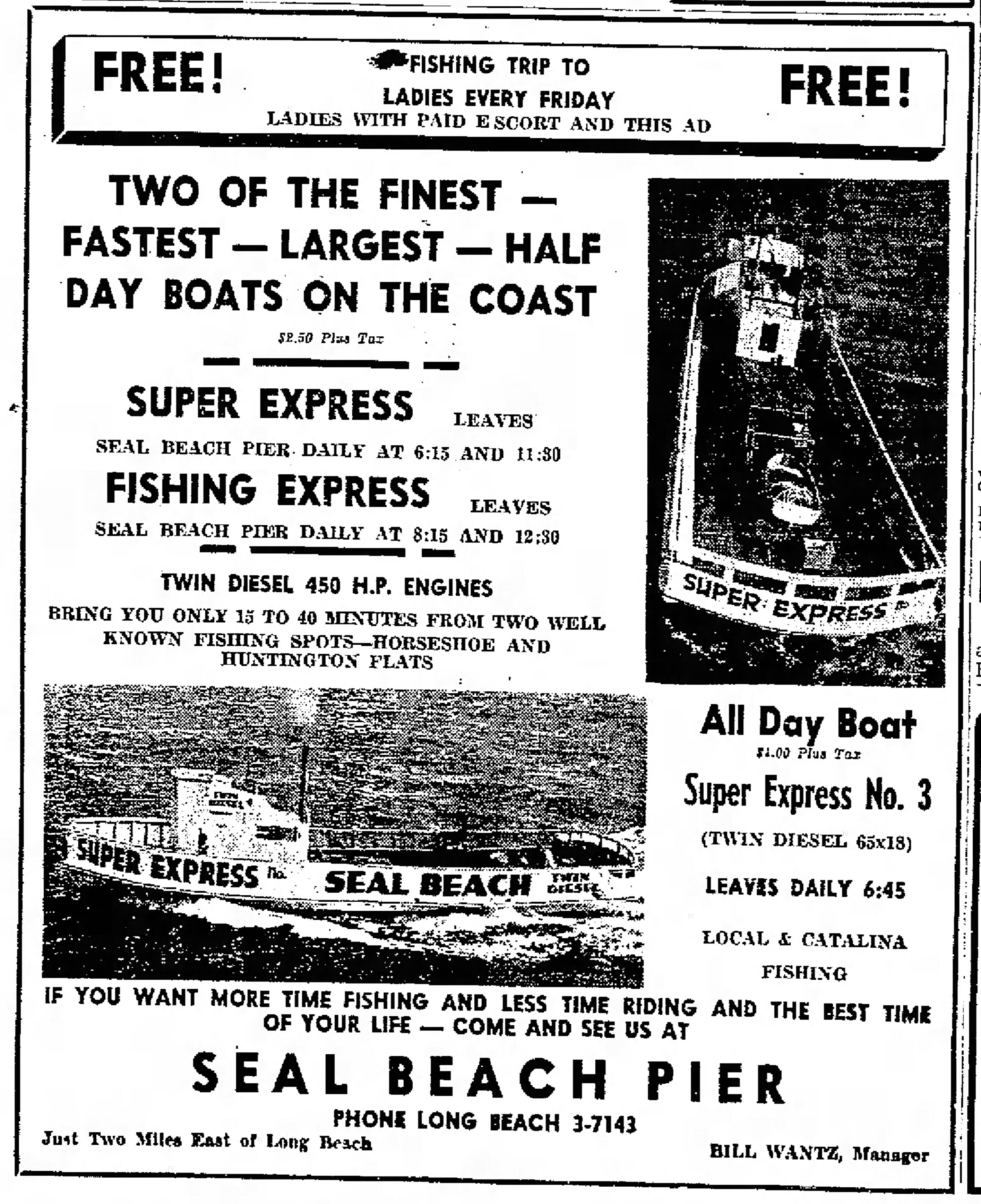
Advertisement in the Long Beach Independent, July 19, 1948
Rod and Reel — Barge fishing is slated to become part of the Seal Beach operation this week as the 300 foot “C-Coaster” will go into commission. The big flatboat will be anchored off the end of the Seal Beach Pier, starting today and before towing it out to its permanent location on the “Omaha” banks, at the edge of the Horseshoe Kelp, open house will be held for all visitors. —Jack Adams, The News (Van Nuys), July 9, 1963
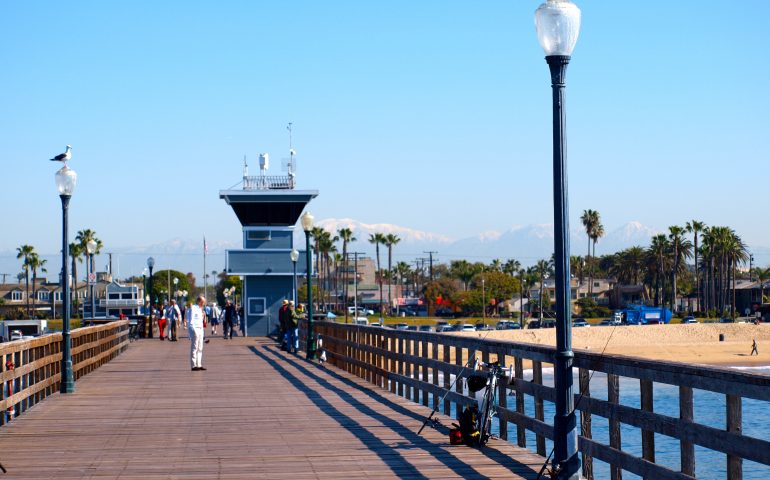
Parking is $10.00 per day..not $6.00
Thanks for the update.
Is the end of the pier open yet?
Was there Monday April 8 and it was still closed
Thanks again for the update. Ken
6/9/2019
Can one still fish off the pier while their working on it?
My aunt lives by the pier, and I was talking with her today. She just told me that they opened the end of the pier. I’m probably gonna try for some Bonito or Sardines this summer. Pretty exciting.
When they first opened up the end good fishing was reported. Hoping it continues.
Good luck, Ken
Thanks very interesting ! I visited Seal beach once and hope to do more!
Your story is very informative in terms of local fish !